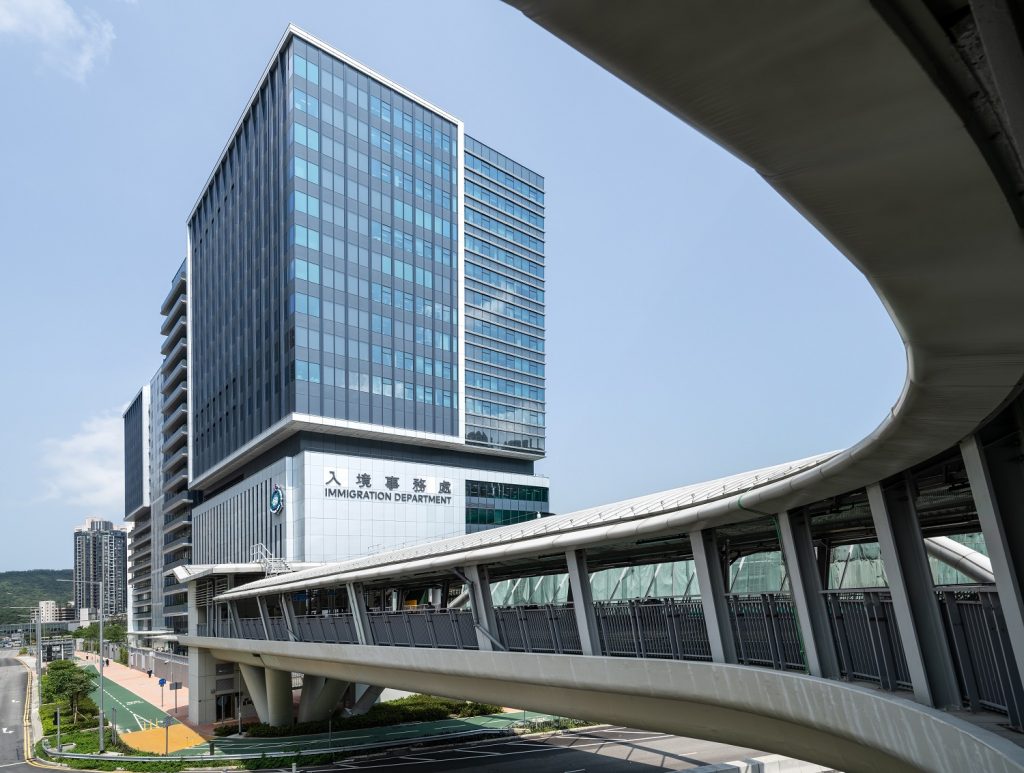As the sun sets on Hong Kong’s Revenue Tower and Immigration Department buildings in Wan Chai, the Architectural Services Department—together with Far East Façade—puts their finishing touches on the new Immigration Headquarters in Tseung Kwan O.
(按此瀏覽中文版)
Last year, the new Immigration Headquarters in Tseung Kwan O opened its doors at 33 Tong Yin Street. Designed by P&T Group and built by Hip Hing Engineering, the project was brought to life through the collaborative efforts of the Architectural Services Department (ArchSD) and Far East Façade.

Embodying modern architectural innovation, the structure features a 17-storey Administrative Tower divided into North and South Wings, a 16-storey Enforcement Tower, and a basement car park, covering a total construction area of approximately 140,000 square metres. Operations began in June 2024, setting a new standard for government buildings in Hong Kong.
The façade incorporates advanced materials and technologies to enhance energy efficiency and aesthetic appeal. It features high-performance glazing that reduces solar heat gain and maximises natural light, contributing to the building’s overall sustainability goals. The sleek, modern design of the façade improves the building’s environmental performance, as well as complements the surrounding urban landscape—marking a significant departure from the traditional government building aesthetics.
The move from Wan Chai’s Immigration Tower to Tseung Kwan O symbolises a shift in Hong Kong’s administrative geography. Wan Chai’s tower, once the 93rd tallest building in the city, has played a significant role in government operations since its opening in 1990. The relocation to a state-of-the-art complex reflects a broader transformation in urban planning and governmental architecture, aiming for enhanced efficiency.
After the government moves the service from its Wan Chai office to a new one in Tseung Kwan O, people on Hong Kong Island will have only one office that issues passports and other travel documents from next month.
The change, part of the plan to transfer the Immigration Department’s headquarters, will leave the Travel Documents Issuing Office in Central’s Harbour Building as the sole travel documents issuer on the island. The department said that more automatic machines for travel document applications and collection would be added to the Tseung Kwan O and Central offices to cope with an expected rise in demand.
Architectural innovations and design features
The new headquarters’ façade design incorporates features to mitigate glare, enhancing the building’s visual comfort and energy efficiency. The curtain wall’s architectural elements were carefully developed to reduce direct sunlight penetration, improving the indoor environment for staff and visitors. This design aspect is part of the building’s wider elevation concept, focusing on sustainability and user comfort.
The design of the curtain wall not only serves an aesthetic purpose; it has strategically placed shading devices. These features help in reducing the reliance on artificial lighting, saving energy. The integration of green spaces within the complex is another highlight of the design.
Landscaped gardens and green roofs enhance the aesthetic appeal of the headquarters, contributing to the well-being of its occupants. These spaces provide areas for relaxation and recreation, promoting a healthy work environment.
Sustainability through solar energy and RFID technology
The façade’s production emphasised sustainability, targeting energy efficiency and carbon emissions reduction. Manufactured in Zhuhai, Guangdong Province, just under 150 kilometres from the Tseung Kwan O site, the proximity significantly cut transportation-related carbon emissions. The production facility leveraged full automation and digitalisation, including automated water tests for façade units, ensuring higher quality and reducing human error.
Incorporating RFID technology, the project employed a ‘Digital Twin’ concept to track façade unit process states and material information. This innovation enhances future maintenance and lifecycle management, boosting the building’s operational efficiency.
The manufacturing process primarily relied on solar energy, approaching “net zero carbon” operations, due to Far East Façade Group incorporate Building Integrated Photovoltaics (BIPV) system in the factory for facade manufacturing.
This integration lowers operational costs and contributes to the reduction of greenhouse gas emissions. Tseung Kwan O’s new Immigration Headquarters reimagines Hong Kong’s bureaucratic landscape, marking a new chapter in the city’s urban narrative. This sleek, eco-conscious building replaces the old Wan Chai offices, introducing a green element to the city’s bureaucratic hub.
Project Participants: Architectural Services Department of HKSAR
Architect: P&T Group
Main Contractor: Hip Hing Engineering Company Ltd.
Façade Contractor: Far East Façade (Hong Kong) Ltd.
Text: Julienne Raboca
Photography: Tam Wai Man

















